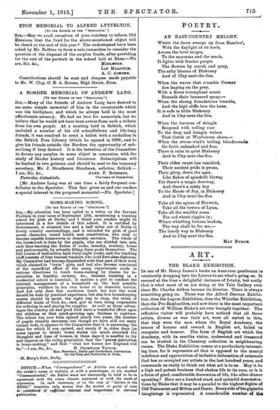ART.
THE BLAKE EXHIBITION.
IN one of Mr. Hemy James's books an American gentleman is constantly dropping into the Louvre to see what's going on. It seemed at the time a delightful instance of fatuity, but really that is what most of us are doing at the Tate Gallery ever since Mr. Charles Aitken became its director. There is always something going on. There was the Alfred Stevens Exhibi- tion, then the Legros Exhibition, then the Whistler Exhibition, then the Pre-Raphaelites, and now there is the most important collection of William Blake's art ever brought together. The reflective visitor will probably have noticed that all these artists, diverse as was their art, were all united in this, that they were the men whom the Royal Academy, the source of honour and reward in English art, failed to recognize and honour. The form of English art which the Academy, with its seerlike vision, understood and treasured can be studied in the Chantrey collection in neighbouring rooms. The Blake Exhibition comes at a particularly interest- ing time, for it represents all that is opposed to the mental indolence and appreciation of imitative delineation of externals that has so occupied our artists in the last hundred years, and commands us really to think out what art is to us. May it be a high and potent business that shakes life to its core, or is it a form of good, comfortable decoration of life, like after-dinner speaking ? Here are a hundred stark and splendid demonstra- tions by Blake that it may be a parallel to the highest flights of Old Testament and Milton and Dante. Every side of his gigantio imaginings is 'represented. A considerable number o be =fifty small pictures he painted (at a guinea apiece) for Muster- master-general Thomas Butts are here, lent by the Linnell `Trustees, and these include nineteen designs for Dante which have not hitherto been publicly shown in our time. In these the rhythmic and most arbitrarily selective side of Blake's art is wonderfully expressed. In some of the pieces the chief objects are picked out and their surrounding hardly indicated, as in Chinese painting or, curiously enough, in the drawings of the Post-Impressionist Cezanne, under -whose hand the subject seemed to flower or disappear with the movement of his own interest. Mr. Graham Robertson also has lent many noble pieces from the Butts Collection and else- where, the great Elohim Creating Adam taking first place. Here Blake challenged Michael Angelo himself, and in the terrible .ancient figure of Elohim in the agony of creation we see how little in the highest range of the imagination the understand- ing of anatomy and the drawing of schools have to do with the -ultimate message of art. Blake had brought his drawing to the pitch when it did not interfere with his astounding designs and images, and his work was always on a scale friendly to his -draughtsmanship. One of his proofs of greatness as an artist a that he understood his own art. Sir John Stirling Maxwell 'has lent The Vision of the Last Judgment and many other pieces, and Mr. Sabin eight designs for Comus. The Canter- bury Pilgrims is shown beside Stothard's picture of the same 'name, and the old quarrel can be fought out again by those -who care to do so ; but the main point of the juxtaposition is that even the delicate Stothard looks otiose beside the -unearthly and absolute imagination of Blake. No one who -cares for English art in its noblest soarings should miss this .exhibition, to which Mr. Archibald G. B. Russell's catalogue, with its rare combination of learning and insight, forms an































































 Previous page
Previous page